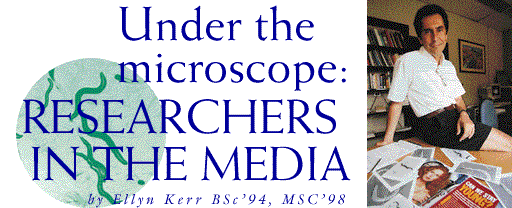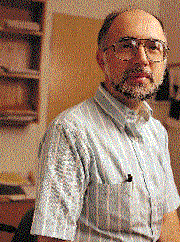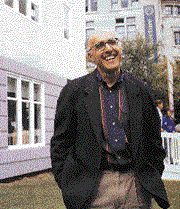
Imagine that for simply doing your daily work, you attracted the attention of the New York Times, Maclean's, Time magazine and the New Yorker. Picture being invited to appear on the Discovery Channel, CTV News and the BBC World Service.
That's what happened to McGill biologist Siegfried Hekimi, who, along with a team of graduate students in his lab, has discovered genes linked to aging. Given the greying of the baby boomers and the public's intense interest in medical advances, his work shot to the forefront of media coverage.

The Montreal Neurological Institute's Dr. Robert Zatorre hit the headlines when he and his colleagues discovered that some people have a predisposition to perfect pitch. Their brains learn and process music differently, according to Zatorre, who plays the organ and says he is among the 97% of musicians without this unique ability.
I usually enjoy media contacts, though it does take up time in some instances, such as when someone wants to do some filming. I also enjoy good science writing as a leisure activity, so I am very conscious that such writing takes the cooperation and involvement of other scientists.
It's always gratifying to think that someone else may be interested in one's work, and it's therefore encouraging to be able to talk about it to others and have it disseminated. As far as I can tell, however, there is no relation at all between media interest and funding. Some of the work that I've done on music perception, for example, seems to be of considerable interest to the media -- and presumably to the public who read, listen to and view what the media produce -- but this work has not been easy to get funded. The research questions I pursue are based on scientific issues and curiosity.
Pros and Cons
A positive spin-off from doing interviews is that other investigators or groups may hear of what one is doing, and they may get in touch. This has happened to me on a few occasions, when people in other fields of science who might not have known of my work contacted me after having read something about me in a newspaper or heard a radio interview. This has resulted in good contacts and exposure.
Journalists, just like scientists (or anyone else for that matter), vary from being very well-informed and intelligent to being hopelessly bad at what they do. So the ones who don't have a clue about science and/or are poor at conducting interviews or have poor writing skills predictably turn out terrible pieces.
There are also some media people who may be perfectly intelligent, but in fact are not at all interested in what one is doing per se, and merely need some filler for a program, or just want to meet a deadline regardless of content. These people are usually quite insistent and demanding. This situation also results in some terrible, totally superficial and even wrong stuff.
|
It all started with a worm so tiny that a chain of ten joined head to end would still measure less than the width of a finger. The daunting nomenclature of Caenorhabditis elegans belies its minuscule proportions and short, uneventful life. Essentially, C. elegans (as it's abbreviated in scientific parlance) moves, digests, reproduces and dies.
Geneticists like Hekimi, however, have reason to love the transparent roundworm. Because of its transparency, the growth of C. elegans from embryonic stages can be easily traced at a cellular level using a microscope. Individual animals exist either as males or self-fertilizing hermaphrodites; hermaphroditic worms make it easy to propagate a particular genetic make-up that you want to study. Finally, the two-week life span of the worm means you can play with its genes and quickly see the results of those manipulations.
"They talk to me, at different levels," Hekimi says. "I speak metaphorically, of course. With the naked eye, you can see only movement, you can only know when it has moved. But you look under binoculars, under the microscope, then at the electron microscope level, and each time you see more and more into the organism."
In May 1996, Hekimi and graduate student Bernard Lakowski published in the prestigious academic journal Science their discovery of four genes in C. elegans which act together to determine life span. When mutated, these genes caused a manifold increase in longevity.
Hekimi and Lakowski named three of the genes clk-1, clk-2 and clk-3, or "clock genes," because they seemed to act like a physiological body clock. Using these genes, they slowed down the speed of biological functions, and extended the worms' lives.
Then in February 1997, Hekimi and members of his research team co-published findings, again in Science, that the clk-1 gene of C. elegans has a counterpart in humans. Exactly how the genes function remains to be determined. But the idea of a human clock gene riveted the media's attention.
Articles about both discoveries appeared in The Globe and Mail, the Ottawa Citizen, Philadelphia Inquirer and Los Angeles Times on the same day each breakthrough was published in Science. After the first newspaper stories came feature articles and mentions in magazines. Radio and television profiles followed. Hekimi gave no fewer than 29 interviews to major media outlets as word of the isolation of the "aging gene" made his name a media buzzword.
When asked how all this attention has changed his professional life, Hekimi's answer is succinct: "Not very much." Such extensive media coverage brings a degree of fame, but, says Hekimi, "the notion that there's some glamour to being a good scientist is misconstrued."
What the media fail to report, of course, is that behind every major scientific discovery are literally thousands of work hours, many of them to repeat experiments that have frustratingly gone awry or that have produced unclear data. Add to the repetitive nature of the work a requirement for spending long hours on your feet, putting in frequent late nights and handling radioactive materials and biohazardous chemicals, and even a non-scientist will begin to realize that science in daily practice may not be so glamorous. As Hekimi concedes, "It is often very boring."
To see projects through, researchers must above all possess extraordinary tenacity. Hekimi recalls a telling experience from a fourth-grade physical education class.

Dr. Margaret Somerville of McGill's Centre for Medicine, Ethics and Law is a familiar source for reporters covering the ethical side of new issues like cloning and old ones like euthanasia. She estimates she has "several hundred" media contacts a year. Her views on what she acknowledges has become a "major commitment"?
It is a necessary function of a university -- and in some cases it can even be an obligation -- to inform the public. Often this can be best fulfilled through the media -- indeed, it may be the only way in which it can be fulfilled. Perhaps, in some instances, it can even be regarded as a form of teaching in a very broad sense of this term.
I believe that we are in the process of developing a new societal paradigm -- the shared "story" which consists of fundamental values, principles, attitudes, myths and beliefs that we all buy into in order to form society. The media provide the public square -- the forum -- within which the major societal issues at the end of the twentieth century, many of which fall within the area of medicine, ethics and law, are being debated.
There may still be some lingering attitudes among academics that it trivializes and vulgarizes, in a bad sense, our knowledge and academic status to participate in the media and that the public is not educated or well informed enough to take part in our discussions. I believe this is not only wrong, but dangerous.
Pros and Cons
I believe my media exposure has been largely responsible for many of the invitations I have received to speak at conferences and other similar professional gatherings. It has often put me in contact with issues and arguments I felt needed to be addressed in both greater depth and a more academic mannner, and I have used these issues as a starting point for many of my academic publications.
Perhaps the most dramatic positive experience I had was when a columnist in The Globe and Mail wrote a very laudatory article about the then-new McGill Centre for Medicine, Ethics and Law. This column appeared on the morning of a meeting of the board of directors of a major Canadian foundation to which we had applied for funds. Each director found a copy of the article at their place at the table. We were awarded over $500,000 in research funds.
I do receive negative feedback from some of my media appearances. The most frequent comment I hear is "I can't stand that woman," and CBC once told me they received a letter of complaint in which a viewer said that if he ever saw me on television again he would throw a brick through his TV! I try to learn from these comments -- whether my manner, choice of language, attitude, etc., might have been barriers to people being open to hearing the information and analysis I was presenting.
|
"We'd run in a circle, and the idea was to stop last. My idea was simply that you command the muscles to keep running and you should win. I never could understand -- I had real conceptual trouble -- how anybody would stop running."
As for monetary reward, it's rare that a scientific discovery made at an academic institution brings a researcher personal financial gain. What does occur -- as it has in Hekimi's case -- is industry support for the research project itself. Running a laboratory can cost tens of thousands of dollars annually, more than could be provided by a university's budget alone. Professors usually submit grant applications to funding agencies like the Natural Sciences and Engineering Research Council (NSERC) or the Medical Research Council (MRC). Grants are competitively awarded, but in the current climate of budget cuts for universities and funding agencies alike, research money is harder to procure. Media coverage is unlikely to sway these funding agencies. Biotechnology, however, is a booming industry, and private funding sources can have much deeper pockets than NSERC and MRC.
"It is not because of exposure in the press that one gets funding. It is because these projects are published in good scientific journals that one then gets interviewed by the press. The difference is that after media exposure, [outside interests] will come to you. You don't have to go to them to seek funding."
So, with an influx of new funds, Hekimi is starting a biotechnology company supported by "other commercial interests." The company is called Chronogen, a name he chose both for its association with his research goal to elucidate the genetic mechanisms of aging and for its ready comprehension by scientist and lay person alike. A physical site for Chronogen is part of a long-term plan, but for now, research continues in Hekimi's McGill laboratory. Even after Chronogen is established, the rules for its operation will in large part be determined by the University's policy for spin-off companies. McGill is deemed to have an interest in any enterprise based on work carried out at the University.
Media attention has also affected Hekimi's work in more subtle ways. For one, the duty of public relations has been added to his job description. At a time when budget cuts are not uncommon, and are even expected, the necessity of popularizing science is readily acknowledged by researchers. Even if a scientist dislikes the intrusion of media upon time designated for research, public interest in medical affairs makes reporters persistent. Eventually, Hekimi says, one learns to negotiate a new role as a public figure.
"There was a long stream of interviews and I got better and better -- though I think I was never really very bad -- at putting things into an everyday context, so that people with no scientific background could understand."
Beyond a role as translator of the jargon native to genetics, Hekimi became adept at some technical elements of successful broadcast interviews.
"There was one interview with CTV -- I know how I talk, with a range in volume and I gesture. I know how the microphone must be placed to pick up my voice. But these technicians did not pay attention, and in the end they had to subtitle me so I could be understood!"
Hekimi has also been developing a critical eye for science journalism. He checks news sites on the Internet, and doesn't like much of what he finds.
"The way most journalists attempt to make a story accessible is utterly vulgar, by making it like street talk. It's terrible. It's ugly." Hekimi's brow furrows as he derides the frequent oversimplification of science in the media. "The classic [report] is that someone found a gene for something. Scientists talk in terms of linkages, genes being associated with a certain trait. But it is reported as the gene for homosexuality, the gene for asocial behaviours, the gene for anything you want.
"That is normal, that the journalist has a hard time to explain what a discovery does mean and doesn't mean, because it's not easy for us to explain to them either. But on top of that, what are never presented are corrections, errata. It's remarkable how often claims are withdrawn, especially when the claims are more substantial. But reporters are not interested in that, because people are only interested in the positive news."
Hekimi himself has been careful to downplay the significance of his results. Although the media seemed eager to attribute human aging to a few, perhaps treatable, genes, Hekimi has stressed in interviews that the precise function of the human equivalent to the clk-1 gene is still unknown, and that an increase in human longevity is not likely to result soon from his discoveries.
But he acknowledges reasons for the media frenzy.
"Maybe it's because aging is something which touches the public in a weird sort of way. Everybody's going to die, right?"
Ultimately, his drive for scientific knowledge -- like his determination in the fourth grade running contest -- may stem from his inability to comprehend giving up.
"If one doesn't believe in a metaphysical life after death, one becomes then obliged to learn as much as one can about the natural world," insists Hekimi. "It would be a shame to die stupid."

Professor Avi Friedman of the School of Architecture has made international news throughout the '90s as he has worked to bring attractive, affordable housing to the market. His research has resulted in the temporary construction on campus of full-size models of the Grow Home (in 1990) and the Next Home (1996). Versions of these projects are now being built all over North America and in Mexico.
High-profile media status should not compromise academic standards. I publish extensively in academic venues. However, I have learned to use any media status I have gained as a support system for my academic endeavours.
My work falls squarely in the category of applied research. Constructing innovative housing is a difficult challenge, given a conservative homebuilding industry. The media have helped me to bring new concepts to a wider audience. A front-page article in the New York Times or Los Angeles Times or an appearance on CBC's The National draws international attention to my work. Among the interested audience are builders who have been willing to construct these housing concepts which has generated a domino effect: develop concepts and build projects, more media coverage, more research and development grants, more concepts.
The reputation of a university in the mind of the general public is created through the popular media. Future students and their parents do not read refereed articles in academic journals. Newspaper and TV reports about a discovery made at McGill can reach millions overnight. In an environment where many universities are competing for excellent students, media coverage of this nature is a huge bonus. In times of budget cuts, it should be seen as a form of free advertising.
Pros and Cons
The media have become an ally in my quest to have more affordable housing built in North America. Articles about our work have generated invitations to address numerous academic, government and trade organizations, providing me with opportunities to convey a message and to attract students to my School and University. Approaching an industry or government representative who is familiar with my work through the popular media has facilitated the process of obtaining financial support with no strings attached.
I do not recall any negative experiences with the media, perhaps because housing does not provoke negative responses or because the journalists always understand that my life work is devoted to a common good: affordable housing. Frequently, however, I get distracted by telephone calls. An interview in a large national or international outlet leads to dozens of telephone calls or e-mail messages the following day, despite the fact that no telephone numbers or e-mail addresses were given out. This is part of being known, I suppose.
|
|